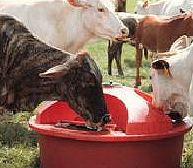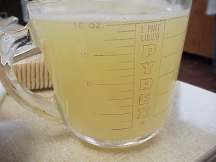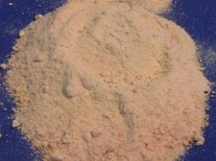Previous Page | Right click this page to print.
High-Carbohydrate Liquid Feeds
The first major group of high-carbohydrate liquid feeds is molasses and similar liquid feeds. Molasses are by-products. The major types of feed molasses are cane and beet molasses. Cane and beet molasses are by-products of sugar production from sugarcane and sugar beets, respectively. Cane and beet molasses are similar in nutritional value. Lesser sources of molasses are by-products of citrus fruits, starch, and wood production. The molasses from citrus fruits are bitter and relatively unpalatable. The liquid products from wood are primarily used as a pellet binder rather than a direct feedstuff. Wood molasses consists of hemicellulose and other water-soluble carbohydrates. Wood molasses should not be fed to nonruminants. Molasses are available in a liquid or a dried form. Liquid molasses is a thick, black solution.
Figure 5.5 illustrates dried molasses.

Generally, dried molasses are not cost effective for animal production. In addition to the traditional molasses and liquid feeds, new processing methods have brought new by-products such as concentrated separator by-product.
Molasses quality is primarily dependent upon the sugar content of the molasses. Molasses quality is expressed in degrees Brix. To determine the degrees Brix, specific gravity of the molasses is measured and applied to a table to determine the degrees Brix. Degrees Brix closely corresponds to the dry matter content of the feed.
Table 5.1 describes the minimum sugar and Brix requirements for cane, beet, citrus, and starch molasses.
Molasses
Type |
Minimum Sugars (%) |
Minimum Density (Brix) |
|---|---|---|
Cane |
43 |
79.5 |
Beet |
48 |
79.5 |
Citrus |
45 |
71 |
Starch |
50 |
73* |
*Total solids |
||
The characteristics and nutritional values vary between the types of molasses. The following discussion will describe the general nutritional characteristics of molasses. Molasses is a good energy source. Generally, molasses are high in sugars; mostly glucose, fructose, and sucrose. Molasses have a low protein content. Molasses are a good source of macro and microminerals. The major macrominerals in molasses are potassium, calcium, chlorine, and sulfate salts. Molasses have a number of favorable milling and feeding characteristics. Molasses aid in pelleting and reduce dust. Molasses can also be used as a vehicle or carrier for other nutrients. One common example of molasses fed with other nutrients, are molasses-urea blocks. Molasses-urea blocks are a favorable energy and protein supplement for ruminants. Molasses are also extremely palatable and promote feed intake. Although molasses has a number of favorable nutritional and feeding characteristics, the maximum amount of molasses in the diet is limited. The optimal amount in the ration is 10%. Greater than 10% reduces animal productivity and may cause feed manufacturing problems. For poultry, maximum inclusion rate is 5%. Molasses are incorporated into the diet in a number of ways. Molasses are often added to the feed at the mill, either mixed with concentrates or included in the pellet. Molasses may also be offered free-choice, in the form of a block with other nutrients or in the liquid form through a feeder.
Figure 5.6 illustrates grazing beef cattle consuming free-choice liquid molasses.

The second major group of high-carbohydrate liquid feeds is milk by-products. Liquid milk by-products are the by-products of cheese production and/or the products of whey. The whey-based products include fresh, acid, condensed, and dehydrated or dried whey.
Figure 5.7 illustrates liquid whey.

Whey is the liquid portion of milk after cheese production. Cheese production primarily removes the casein and butterfat from the original milk. The majority of the water, lactose, minerals, and water-soluble protein from the original milk remain following cheese production. Generally, liquid whey is fed in close proximity to the cheese production plant. Liquid whey has a relatively low nutritional value. The average dry-matter content of liquid whey is 4-7%. Condensed and dried whey have had a portion of the water removed and therefore have a relatively higher nutritional value. The components of condensed whey at 40-50% total solids will be 10-13% crude protein and 55-70% lactose. Condensed whey is fed to cattle, swine, and poultry. Dehydrated whey is whey dried to less than 10% moisture.
Figure 5.8 illustrates dried whey.

Dried whey is fed to ruminants, swine, and poultry. Cost and spoilage are points to consider when feeding whey-based products. The greater the moisture content, the product is less expensive to purchase per unit of mass, but more expensive to transport per unit of nutrients. The majority of transportation cost for liquid whey is transportation cost for water. Spoilage is also an issue to consider with liquid and condensed whey. Additional products, used similar to condensed whey, are condensed whey solubles and condensed whey product. Condensed whey solubles are composed of 10% crude protein and 60-70% lactose. Condensed whey product is composed of 15-16% crude protein and 60-70% lactose and lactic acid.
Two additional high-carbohydrate liquid feeds are condensed soybean solubles and liquefied corn product. Nutritionally, condensed soybean solubles contain 6-7% crude protein and 57% total soluble carbohydrates. Liquefied corn product contains 8-9% crude protein and must contain at least 30% solids.
Additional liquid feeds containing a lower carbohydrate content are extracted streptomyces solubles, condensed molasses solubles, and citrus condensed molasses solubles.
Previous Page | Right click this page to print.